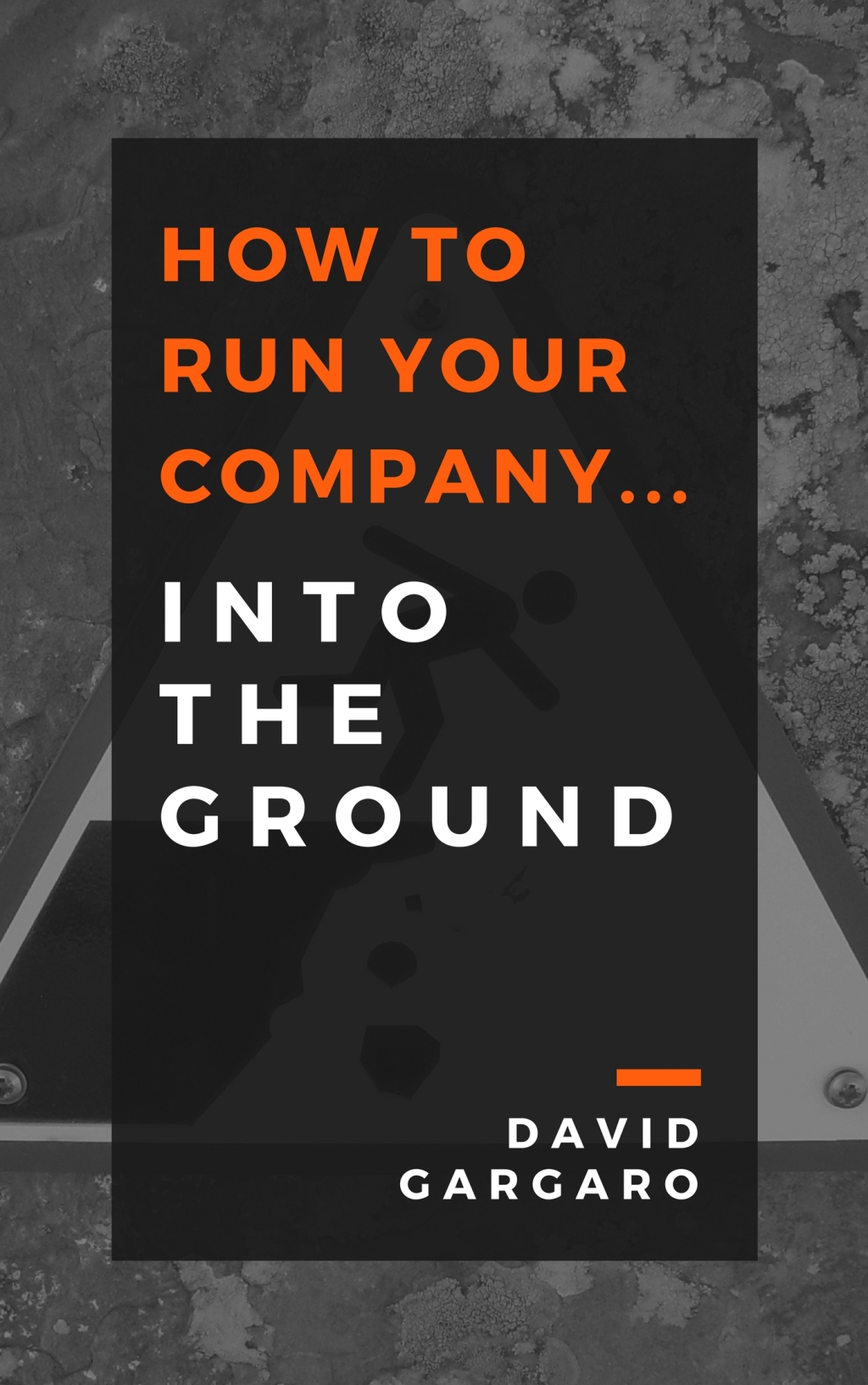 A couple of months ago, I published How to Run Your Company… Into the Ground (Amazon.ca and Amazon.com, if you’re interested). To follow is the introduction and the opening chapter, for those of you who are interested in reading it.
A couple of months ago, I published How to Run Your Company… Into the Ground (Amazon.ca and Amazon.com, if you’re interested). To follow is the introduction and the opening chapter, for those of you who are interested in reading it.
*****
How to Run Your Company… Into the Ground
By David Gargaro
Introduction
Why would anyone write a book about how to fail in business? It seems counterintuitive. You don’t have to be an expert to fail. People go out of business every day. It’s not that hard to do. And why would anyone want to read about how to run your business into the ground?
Well, there are three key reasons why you should keep reading – and why I wrote this book:
- We learn more from our failures than we do from our successes.
- Understanding what not to do in business can help you to identify what you should do to succeed.
- Some stories are so ridiculous (and true) that they just must be told.
How to Run Your Company… Into the Ground is the (mostly) true story of my time with a small publishing company that is somehow still in business today. The hapless owner of this enterprise had many chances to grow and succeed, but he found numerous ways to snatch defeat from the jaws of victory. He made every mistake in the book, and some that he invented.
Please note that most participants’ names have been changed to protect the innocent… especially me. While the facts are true as I remember them, the main character is very litigious. He’s been sued a lot(and he has also sued a lot of people), so I would rather not end up in court with someone who has that much experience with the process.
Background
Steve (not his real name) is the owner and founder of FastNotes (not its real name), a small company that has been in business for more than 20 years. Its main function is to publish “cheat sheets” that summarize and explain college and university subjects, such as mathematics, chemistry, literature, history, law and anatomy, as well as software, health and safety, general interest, business and more.
FastNotes initially hired me to write and edit its titles on a freelance basis. I later created the role of Managing Editor, where I was responsible for developing the style guide, hiring and training freelance writers and editors, creating new cheat sheets, and performing other duties. As it was a small company, I participated in many other company functions. For example, I attended a few trade shows, worked with sales to create marketing materials, developed and managed the company’s website, wrote a newsletter and interacted with customers.
During my seven years with the company, I outlasted three design managers, seven sales managers, and an untold number of salespeople and other office staff. I witnessed several rounds of growth and decline, as well as good and bad moments. There was a time when I was proud to be part of something that I helped to grow; I was responsible for increasing productivity, as well as improving and expanding the product line. I left because I could not stand to work another day in such a hostile environment. That is a chapter (or a book) unto itself.
What you’ll learn
Steve made a lot of mistakes in running FastNotes, and any one of those critical errors could have ruined the company. He managed to survive due to perseverance, a little bit of luck and a lot of financial backing from his in-laws. We learn from our failures and the failures of others. You’ll learn about Steve’s mistakes, why they were harmful and the consequences of those missteps. You’ll also receive tips, suggestions and advice on how to handle the situation properly so that you don’t make the same mistakes (and achieve the right results).
This book covers the following topics, each with its own chapter:
- Working with friends and family
- Forming strategic partnerships
- Hiring the right people
- Developing new products and markets
- Marketing and advertising
- Expanding your operations
- Budgeting and financing
- Holding meetings
- Listening to experts
- Planning
I hope that you enjoy reading How to Run Your Company…. Into the Ground, and learn something along the way. And, of course, don’t make too many of these critical mistakes in running your small business. I don’t want you to be as foolish or careless as Steve… if that’s even possible.
Disclaimer:This book offers general advice on how to more effectively run a small business. The tips and suggestions are based upon my observations of what someone did wrong in running their specific business, as well as what I’ve learned along the way. This book IS NOT intended to solve your specific problems with your business, as I don’t know you or your particular situation. I am not a professional business consultant. I am simply reporting on what I’ve learned and observed. Please take my advice for what it is – useful and informative, but not directive. In other words, please do not thank or blame me for whatever happens if you follow my advice. Make your own decisions, and consult with a trained professional who understands you and your business. Enjoy the read!
Work with friends and family… and treat them like strangers.
Steve was a true entrepreneur, and he was always looking for ways to earn a buck with some new idea or venture. Soon after graduating from university, he created and sold a “cheat sheet” version of the periodic table of the elements. It became a hot seller among university students in chemistry and other science programs. This led Steve to launch a publishing company that he called PaperMaker (not its real name), which he later rebranded as FastNotes (a few years after I arrived on the scene).
Steve’s entrepreneurial business was initially a one-man show. As his business grew, he brought in people to help him handle the tasks that he did not have the time or ability to do himself. As with most entrepreneurs and small businesses, he started working with the people he knew best – his family and friends. His wife became his business partner, his brother worked in sales and his sister-in-law took on various duties around the office. Steve also hired friends, friends of friends and colleagues to fill various roles, such as brokering print services, engaging in various sales functions, doing product development, purchasing supplies, financing and so on.
What went wrong?
Steve did not always play well with others. He tended to see people as resources that could help him to achieve a goal. He treated people well when they were deemed “useful” and less so when they were not. (I’ll talk about about how he treated employees in future chapters.) Some might rationalize the fact that many successful employers are tough on employees and stakeholders, particularly when someone “drops the ball” in business. However, it is very difficult to justify how Steve treated his family and friends.
Steve had many arguments with his wife about business operations – he let his business life affect his personal life. However, he took it (relatively) easy on her because she was a lot tougher than him. Also, her family was responsible for much of FastNotes’ funding (especially when the company was having financial difficulties). Steve would never risk his nest egg, nor did he have the fortitude to stand up to his wife.
Of course, that did not stop Steve from mistreating other family members and friends. He would regularly fire and later re-hire his print broker, who was one of his long-time best friends. He would regularly hire and fire friends who helped with content development. I had to fire someone he hired once I became Managing Editor as part of my new duties because he didn’t want to do it himself. Steve regularly broke business relationships with friends who were suppliers or service providers, and then tried to appease them later, making promises that he could never keep. He repeatedly abused personal relationships over the course of his business relationship.
Nothing stands out more vividly than how Steve destroyed his relationship with his brother, Chuck (not his real name). Chuck was a salesman who later became sales manager – after Steve fired another sales manager. Steve regularly heaped verbal abuse on his brother when sales fell below various targets or deals did not come through. They also had arguments about ethical issues – that is, Chuck did not like some of Steve’s business practices. For example, Steve bought flowers for a family member’s funeral and charged it as a business expense.
Chuck finally quit FastNotes because he and Steve could not agree on how much he was owed in commissions. This is the polite way of saying that Steve tried to shortchange Chuck on what he earned in direct sales commissions. After working for a short time with a national retailer, Chuck went to work with FastNotes’ biggest competitor! He is currently responsible for increasing his company’s sales, which involves taking clients and sales away from FastNotes. I hear that family functions at Steve’s house are very chilly affairs.
How to do it right
Many entrepreneurs and small businesses hire friends and family to help run the company. They are great sources of cheap (or free) labour, funding and advice, and they can often be trusted to do what’s in the company’s best interests. There is a level of comfort in being around friends and family. You’re familiar with their strengths and weaknesses, and there is a reasonable expectation that they’ll do their best to help you succeed.
Every business relationship that involves working with friends and family can also be fraught with issues, since working in close quarters and trying to operate a business can strain personal relationships. Steve was fortunate to have a large network of family and friends who were willing and able to help him with his business. However, he consistently treated them poorly and put the company’s interests above his personal relationships.
Steve should have followed these basic strategies to protect his personal relationships while helping to grow his business:
Establish a foundation. Set the ground rules for the relationship at the beginning of the process. Explain each person’s role and responsibilities as you would with any employee. Avoid giving special treatment on the job, and be clear in what is expected from the individual. You’re the boss, and you are running a business, so everyone must perform their duties to the required standards.
Match the person to the job. Make sure that your friend or family member can do the job. In other words, hire based on merit rather than personal relationships. They don’t have to be the most qualified person, but they should be capable and willing to do the job. Consider additional training if new skills or knowledge are required due to changes in technology or processes over time.
Separate business and pleasure.You have two different lives with friends and family – on and off the job. Keep your personal and business conversations separate, and clearly differentiate between the two areas. Try to keep personal talk out of the office, and avoid talking business when in personal settings. Avoid mixing the two worlds whenever possible.
Be fair.Don’t give friends and family special treatment at the workplace. At the same time, don’t place higher expectations on them just because you have a personal relationship. This will show them and other employees that you believe in fair treatment for everyone when it comes to the workplace. (Note: We all know that friends and family members receive different treatment. But there has to be some level of fairness on the job, as you could lose good employees who feel that they are getting the short end of the stick.)
Employ mediators.There are times when it makes sense to put someone between you and your family and friends. It would be ideal to have them dealing with a manager or other employee instead of you for daily interactions. The goal is to insulate the relationship on the job to keep an arm’s length distance, particularly when you must convey difficult information.
*****
I hope that enjoyed reading this excerpt from my book, How to Run Your Company… Into the Ground. If you have any questions or comments, please send me an email to contact @ davidgargaro.com.
David Gargaro




 A couple of months ago, I published How to Run Your Company… Into the Ground (
A couple of months ago, I published How to Run Your Company… Into the Ground (



